
Text © Prof. Pietro Pavone

English translation by Mario Beltramini
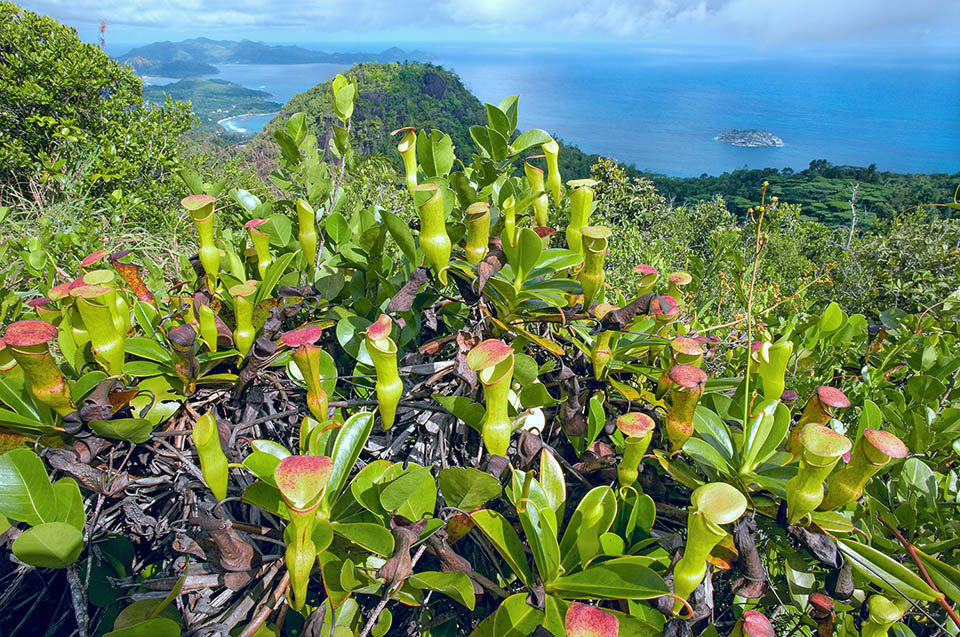
Nepenthes pervillei is the only carnivorous Seychelles plant, endemic to Mahé and Silhouette islands between 400 and 75O m of altitude. Particularly dramatic for its high ascidia number. Shaped like an amphora, the lower ones are mainly red whilst the upper ones are mostly yellow orange. The roots go deep in the granite rocky fissures © Giuseppe Mazza
Nepenthaceae Dumort. (1829) is a monotypic family of carnivorous plants with the only genus Nepenthes L. counting about 180 species and several natural hybrids. This number continues to increase thanks to the scholars who annually discover and describe new species.
They are tropical plants that colonize southern China, Indonesia, Malaysia, Philippines, Madagascar, Seychelles, Australia, New Caledonia, India and Sri Lanka.
They grow up at altitudes varying from the sea level up to 3250 m and are characterized by leaves modified in a sac, equipped with an operculum, called “ascidium” that has the function of catching small animals.
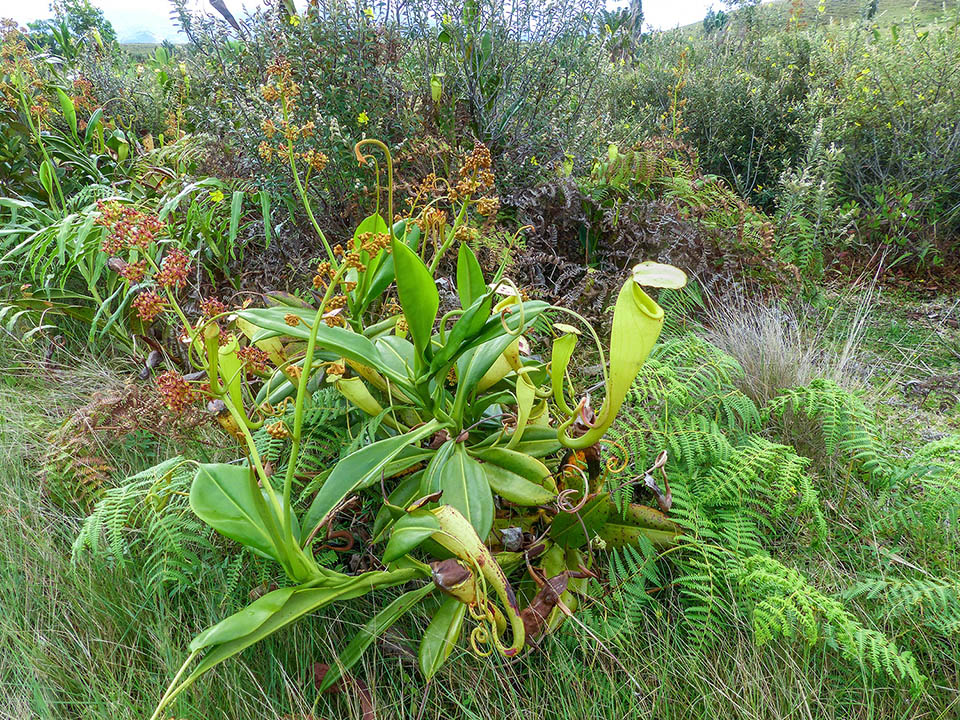
Nepenthes madagascariensis bush with high male panicle inflorescences and infundibuliform pitchers of colour varying from yellow to green, from red to violaceous © Olivier Reilhes
The species of this genus are commonly called “tropical pitcher plants” or “monkey cups” due to their sacs shaped like a pitcher or a cup.
The nickname of monkey cup has been given because these animals, occasionally, quench their thirst with the fluid contained in the traps.
The soils where the species of Nepenthes grow are usually acidic and poor in nutrients, being formed by peat, white sand, sandstone or volcanic soils, therefore low in nitrogen and phosphorus, nutrients indispensable for their growth. Some species thrive on soils rich in heavy metals (i.e. Nepenthes rajah Hook.f.), others on sandy beaches subject to the marine aerosol (i.e. Nepenthes albomarginata T.Lobb ex Lindl.), others live on isolated rocky headlands (Inselberg) .
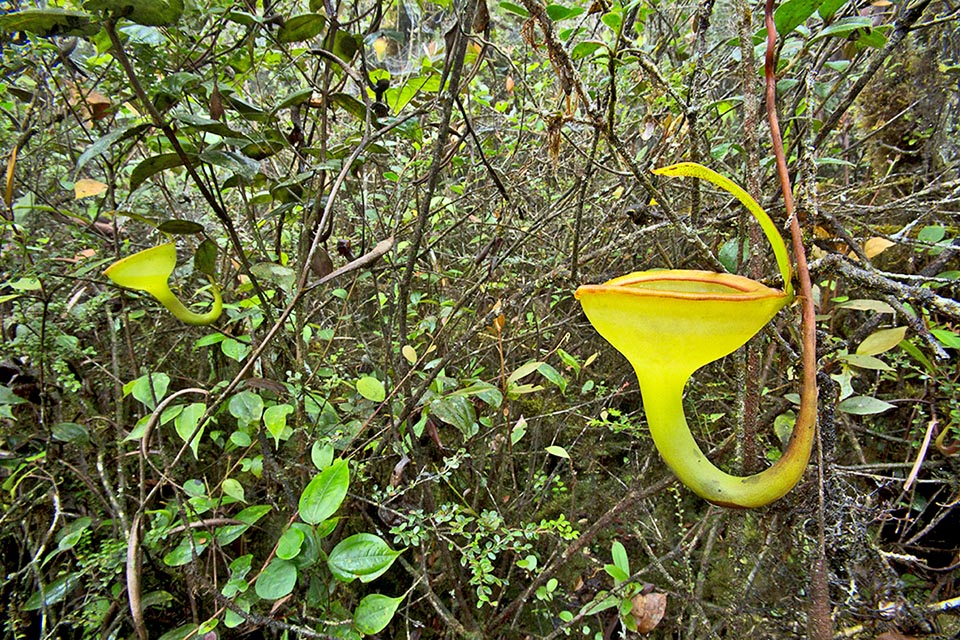
Nepenthes jamban is a species endemic to Sumatra. The upper ascidia, full of a strong digestive liquid, can be 12 cm tall and 5,2 broad, with flat peristome, 6 mm broad with prominent teeth. The cover over the opening of the ascidium is about forty degrees tilted to limit the excess rainwater. They trap numerous prey such as wasps and crickets © Jeremy Holden
And there are even the epiphytes, plants growing without any contact with the soil (i.e. Nepenthes inermis Danser), species endemic to Sumatra, where it grows in the humid mountain forests from 1500 to 2600 m of altitude.
In the past this family was included in the Order Nepenthales, but the Classification APG III (Angiosperm Phylogeny Group, 2009) based mainly on molecular phylogenetics, has included it in the order Caryophyllales.
The family Nepenthaceae gets its name from the genus Nepenthes, which in turn comes from the old Greek adjective νηπενθής, nipenthos, formed by the negative prefix νη, nê, non, and the name πένθος, penthos sadness, pain.
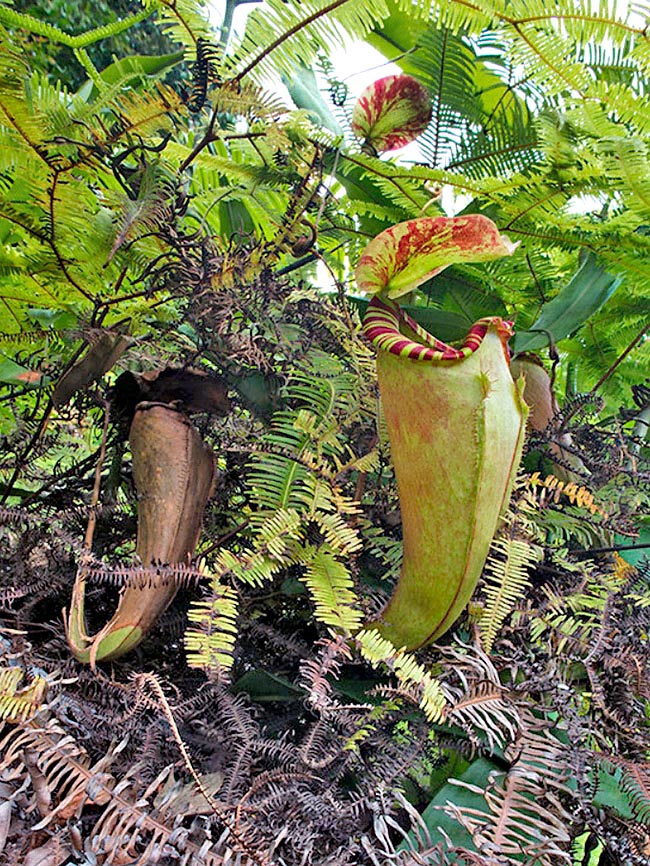
Nepenthes sumatrana is a climbing plant with up to 15 m long stems. It is an endangered species, at risk today due to the very narrow range. Has big lower ascidia, about 10 cm broad and 20 tall. Fringed wings can be 6 mm broad © Jeremy Holden
This adjective is used by Homer in the fourth book of the Odyssey to indicate the beverage “nepenthes pharmakon”
It is said that Helen has received it from Polydamna (Πολύδαμνα), wife of the noble Egyptian lord Thōn (Θῶν), and that, secretly, has poured into the wine Telemachus, son of Odysseus, and Menelaus, prince of Mycenae and her husband, were drinking.
This in order to soothe, thanks to its effect of rubbing the memories, the grief and the nostalgia for the distance of their native country.
Linnaeus in his opus “Species Plantarum, 1753” called Nepenthes distillatoria L. a plant coming from Sri Lanka imagining that the view of this wonder of Nature, after a long voyage, would have the explorer forgetting the hardships in finding it.
The carnivorous plants are present in various families and form a very diversified group, having in some instances little more in common than their carnivorous posture.
Recent biomolecular and biochemical analyses have suggested to include various taxa, with carnivorous plant characteristics, to the order Caryophyllales.
To this order consequently belong the families Droseraceae, Nepenthaceae, Drosophyllaceae
(Drosophyllum lusitanicum), and Dioncophyllaceae (Triphyophyllum peltatum), considered as of the same clade due to the same morphology of the pollens and of the petioles.
In this clade is included also the monotypic family Ancistrocladaceae with species that are not carnivorous.
On a temporal scale, the divergence of the Ancistrocladaceae–Dioncophyllaceae–Nepenthaceae from the Droseraceae is thought to have happened about 60-70 million years ago, during the Eocene and the late Paleocene.
In turn, the family Nepenthaceae would have got off from the clade Ancistrocladaceae–Dioncophyllaceae during the middle Eocene originating, later, the species of the genus Nepenthes during the Miocene (15-5 million years ago). Finally, it is thought that the genus Nepenthes has colonized the Malay area during the Late Miocene (6-4 million years ago).
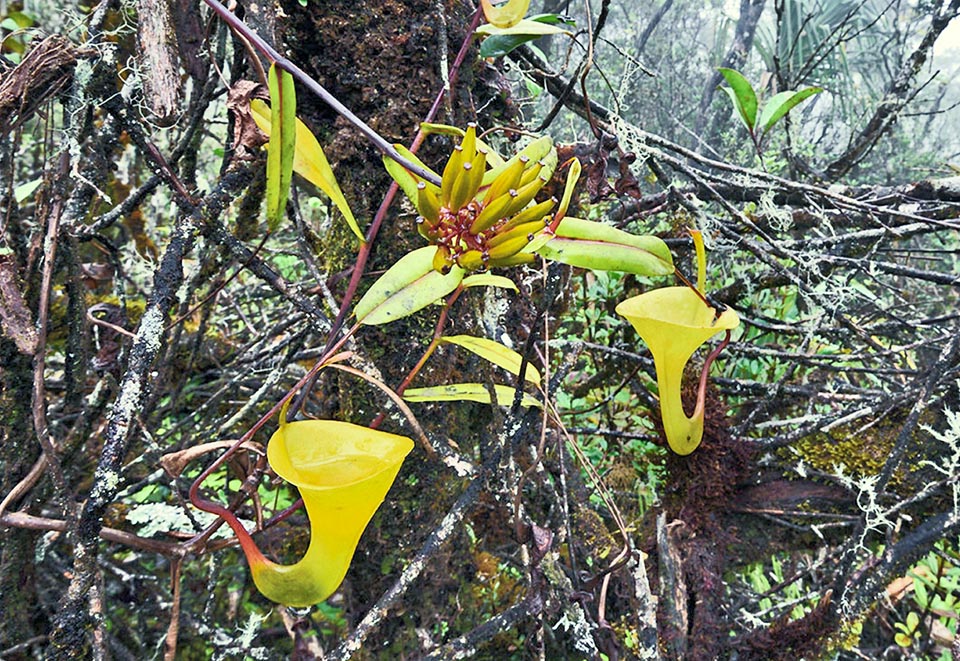
Nepenthes inermis with unripe fruits and ascidia without peristome. They contain very dense mucilaginous liquid and in transparency we see the prey © Jeremy Holden
Within the genus Nepenthes exist species with panicle inflorescences, that is, ramified (i.e. Nepenthes pervillei Blume, Nepenthes ampullaria Jack) and species with not or little ramified inflorescences (Nepenthes ventricosa Blanco). The diversity of the structure of the inflorescence is due to simple changes in the sites of gene regulation that coordinate the expression of the genes and this probably has been caused by the different pollinators present in the colonized area (Borneo).
As Ancistrocladus, Triphyophyllum and similar species have panicle inflorescences, it can be assumed that also the ancestor of Nepenthes had this type of inflorescences.
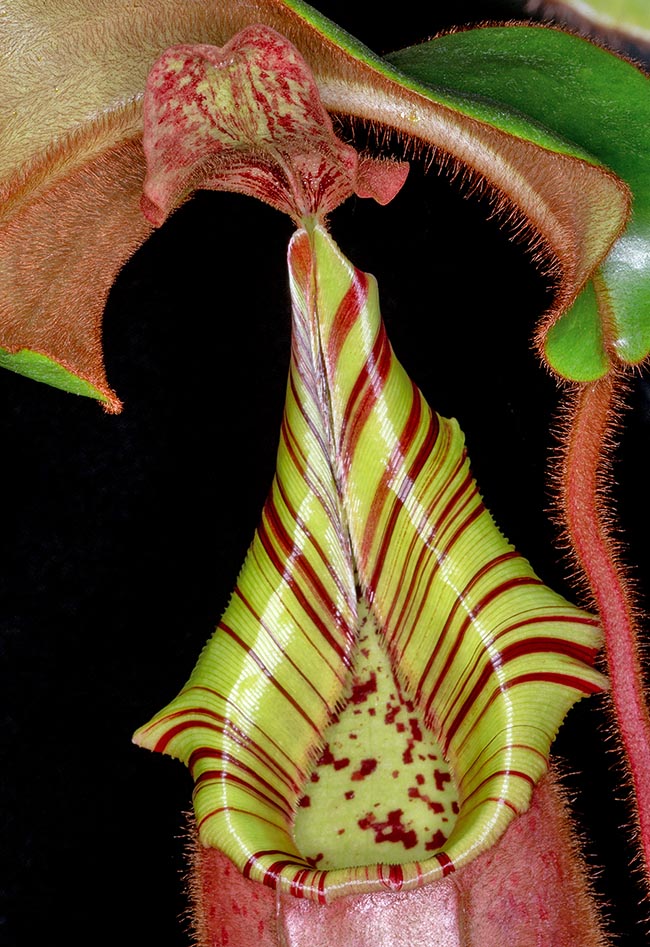
Nepenthes veitchii striped multicoloured flared peristome. This species, densely covered by brown hairs, is endemic to Borneo where it adapts to low humidity values, growing from the sea level up to 1600 m of altitude © G. Mazza
All species of Nepenthes karyologically studied are octoploid (8 copies of each chromosome) with a chromosome number 2n=80.
The increase of the ploidy is advantageous, from an evolutionary point of view, because it confers to the polyploid species a genetic variability able to develop new forms and functions.
However, high levels of ploidy represent a greater physiological cost for the plant, this leads over time to loss of the genes in excess and even of pieces of chromosomes.
In fact, the species of Nepenthes, cytologically, appear to be diploid.
It is also possible that the polyploidy has come after the separation from the line Drosophyllum (2n=12) / Triphyophyllum (2n=24, 36) being Drosophyllum diploid.
After the separation from its relatives and the irradiation, Nepenthes, besides the polyploidy, had another genetic mutation.
From the hermaphrodite flowers it passed to the unisexual ones, therefore the plants became dioecious, that is with individuals with separate sexes, male and female and this condition must have happened before the formation of the species presently known.
This means that the male and female gametes produced by two different plants have placed rather strong constraints to the migration of its species towards new sites, as from the seed may germinate either a plant that will originate male flowers or one that will produce female flowers and consequently the fecundation is prevented. It is however possible that the long range migration has caused the migration of many seeds and this will have made possible the colonization of the new environments.
Molecular studies support the probability that all extant species of Nepenthes have irradiated from one single ancestor with the traits of the modern species.
Fossil pollens of plants, like those of Nepenthes, that lived about 65-35 million years ago on the northern islands of the Tethys, have been found in various European sites (from France to Ukraine).
Originally, they were assigned to the extinct genus Droseridites, however several Authors recently have assigned them, on a temporary basis, to the genus Nepenthes and in particular to the three species: Nepenthes echinatus (Hunger) Krutzsch, N. echinosporus (R. Potonié) Krutzsch and N. major (Krutzsch) Krutzsch.
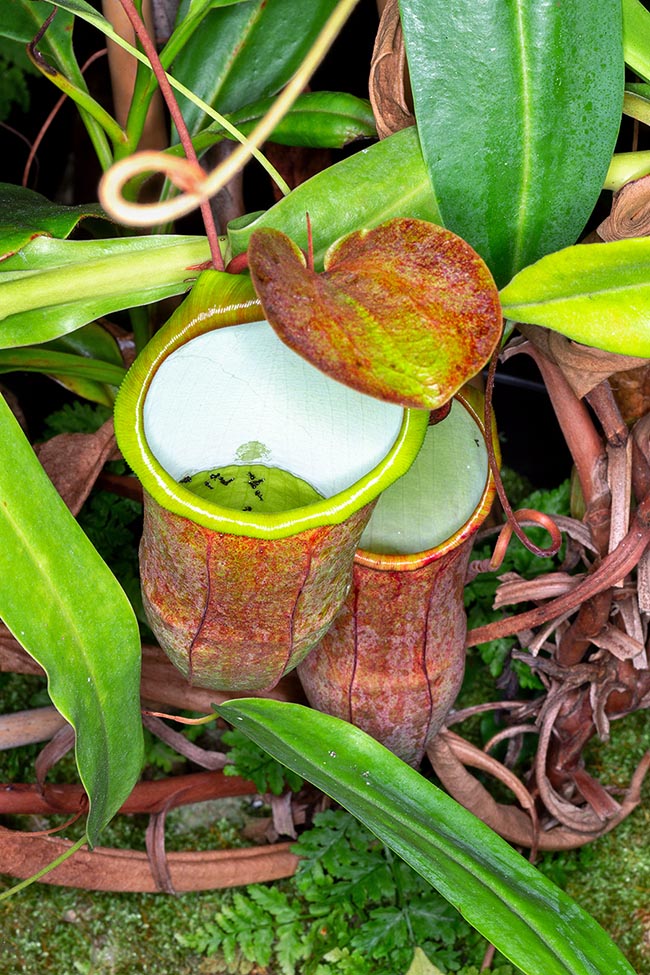
Nepenthes copelandii with insects drowned in the pitcher. Native to Mindanao, Philippines, is a plant easy to grow. The lower ascidia are streaked with dark red or violet, on green background; the upper ones are pipe-shaped © Giuseppe Mazza
Europe, therefore, that at the time was warmer, may have been the place where took form the ancestors of Nepenthes that had connections with the Indian plate while was about to get away from Madagascar and that later on migrated to Asia, when Africa collided with Europe.
Hence it is possible that the ancestors of Nepenthes from southern Africa have gone to Asia through India, whilst the basal species have remained in Madagascar and Seychelles, after their separation from India.
The European taxa, due to the adverse climate changes, became extinct in the Middle Miocene (11-13 million years ago).
The species now present in Sri Lanka (Nepenthes distillatoria) and in India might be the direct remnants of ancestors of a population. that was isolated very early.
As a matter of fact, Nepenthes khasiana Hook.f., endemic to the State of Meghalaya (India), seems to be the last species to branch out 8-15 million of years ago, before the ancestor colonized the Malay peninsula and Borneo originating most of the species of the genus.
In the Miocene, about 20 million years ago, Borneo, Sumatra and Sulawesi and perhaps also the Philippines were connected to continental Asia and this should have favoured the colonization of the sites with major radiation of the species of Nepenthes.
In turn, during the ice age, these taxa have moved further south in Oceania, thanks to the land bridge from Sumatra to the Malay peninsula, and from New Guinea to Australia.
Presently the genus Nepenthes stands mainly inside the Malay archipelago, with the biggest biodiversity in Borneo, in particular in the mountain rain forests, with many endemic species, in Sumatra and in the Philippines.
The Asian south-east is, consequently, the centre of the diversity of Nepenthes, and contains about 95% of all known species of this genus, even if the range of Nepenthes includes Madagascar (Nepenthes madagascariensis Poir. and Nepenthes masoalensis Schmid-Höllinger), Seychelles (Nepenthes pervillei), Sri Lanka (Nepenthes distillatoria), India (Nepenthes khasiana), Australia (Nepenthes mirabilis (Lour.) Rafarin, Nepenthes rowaniae F.M.Bailey and Nepenthes tenax C. Clarke & R. Kruger) and New Caledonia (Nepenthes vieillardii Hook.f.).
Most of the species are present in very restricted areas, in fact, they are found, at times, only on single mountains. Only some of them have a vast diffusion such as Nepenthes mirabilis found in Indochina, in all the Malay archipelago and in Australia.
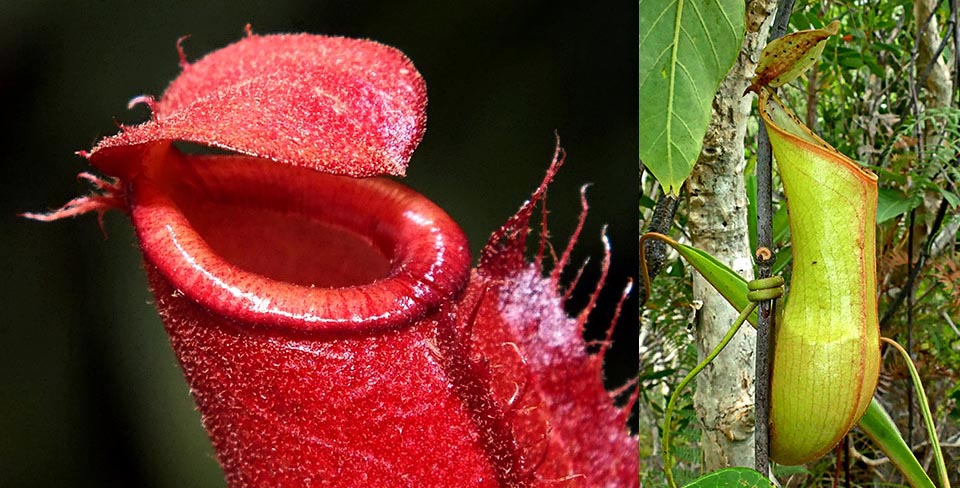
Low and upper ascidium of Nepenthes vieillardii. This species of New Caledonia dry forests lives in symbiosis with the mosquito Tripteroides. caledonicus © Shadowshador (left) and © Benoît Henry (right)
The species of the family are terricolous or epiphyte, dioecious, carnivorous, liana-like, up to 20 m tall (i.e. Nepenthes bicalcarata Hook.f. ), at times sub-shrubs even lightly woody.The root system is usually not too deep.The stem is simple or ramified, erect, climbing or procumbent, glabrous or pubescent, cylindrical or triangular, with 2-4 corners or winged.The leaves are alternate, petiolate or sessile with entire lamina, lanceolate, ovate or oblong and with entire or toothed margins.The leaves are modified whose median vein prolongs in a tendril and the apical part, usually, widens to assume the shape of a cup, of tube, of wineskin, called “ascidium” (from the Greek ἀσκίδιον, small wineskin), inside which forms a cavity, more or less ample, representing the trap these plants use to catch the preys.The pitchers are internally green, covered by glands secreting digestive gastric juices. Externally, they are yellow, orange, white, purple or red, often marked by reddish stripes.
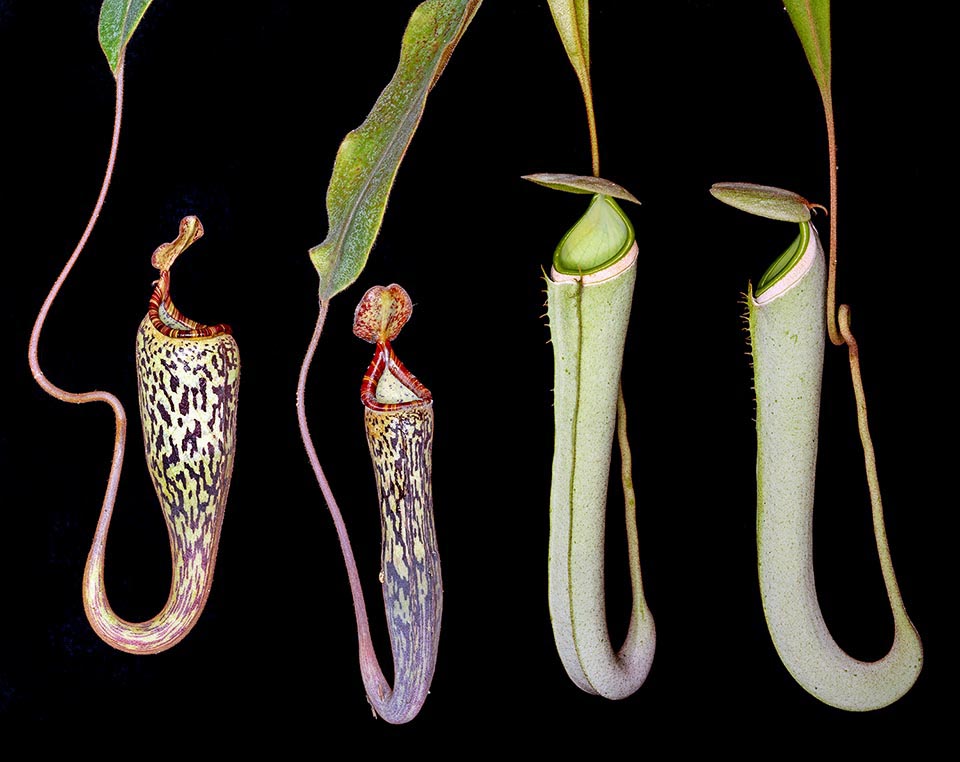
Upper ascidia are mainly long. Their opening is opposite to the stem and dorsal tendrils fixed to a support to keep stable the ascidium with wings reduced to crests or absent as the preys arrive flying. Left, Nepenthes vogellii, right Nepenthes albomarginata with its white band under the peristome for attracting the termites © Giuseppe Mazza
The ascidium has a cover, usually protruding over the opening, on which base is present called “spur” that may be entire or variously divided, flat or with circular section. Normally, the ascidia are dimorphic. Those at the base of the plant are produced by rosettes or short stems, often leaning on the ground, usually ovoid or globose, with the opening facing the stem and with two ventral laciniate wings going from the base to the margin of the ascidium, in order to favour the climb of the apterous preys, with straight, not curled, tendril. The superior ascidia (absent or in a very reduced number in Nepenthes argentii Jebb & Cheek, Nepenthes ampullaria Jack, and Nepenthes pectinata Danser) are usually longer, infundibuliform, with the opening facing away from the stem, with the tendrils curled, to wrap around a nearby support maintaining the ascidium stable and with the wings, reduced to crests, or absent, useless because they catch flying preys.
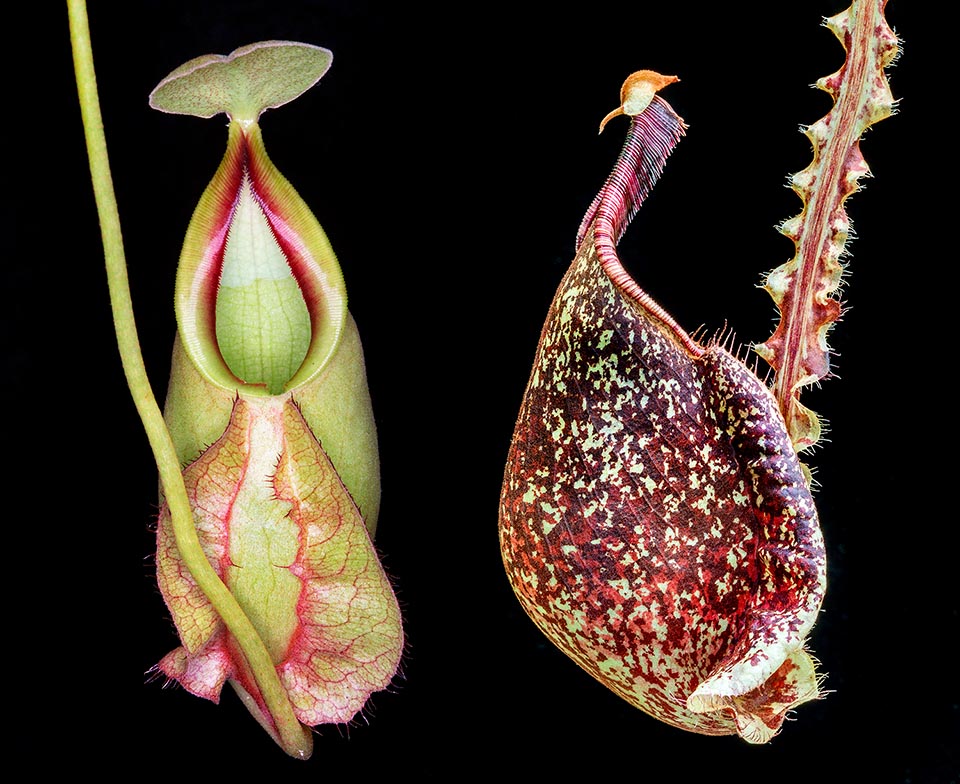
But there are also roundish upper ascidia like in Nepenthes globosa or Nepenthes rafflesiana, right, with the profile like the bow of old Norse warships © Giuseppe Mazza
The apical or sub-apical ascidium has the opening surrounded by a ring of tissue called “peristome” (from the Greek περι peri, around and ςτὸμα stoma, mouth) with veins (except in Nepenthes inermis Danser) with the inner edge usually toothed, with nectariferous glands and, usually, of glossy red colour whilst the rear edge is raised in a columnar shape to sustain the operculum that has the function of preventing the rain water to enter in excess inside the ascidium.
The operculum, on its lower surface, may have nectariferous glands. Epicuticular waxes, very slippery, cover the peristome and the inner upper surface of the ascidia to prevent the insects from going back up along the walls towards the mouth of the trap.
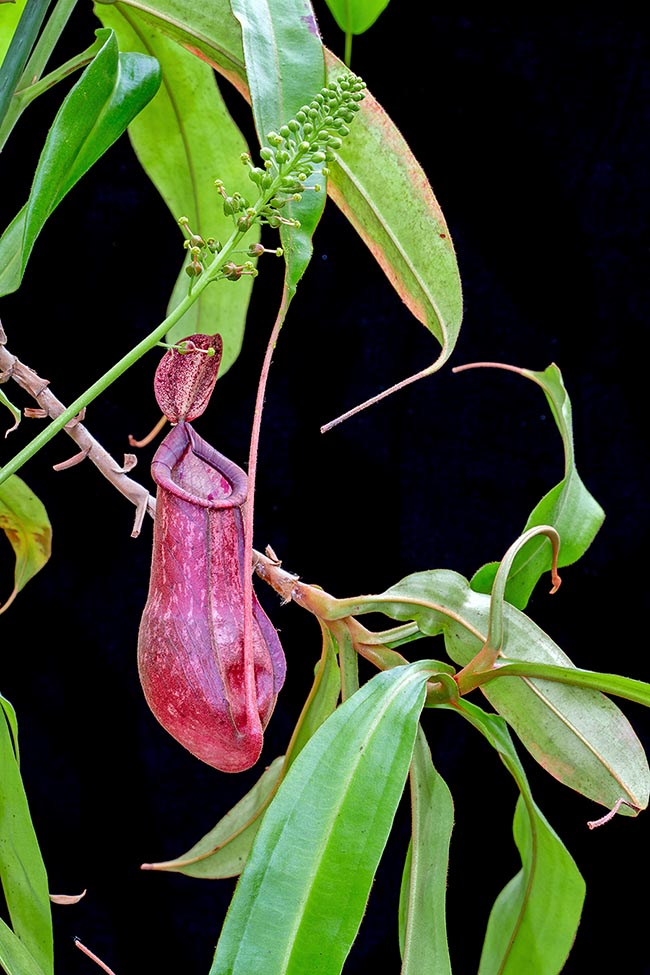
Nepenthes mirabilis is diffused in all South-East Asia, China and Australia. Lives in forests, prairies, in the swamps, on the roadsides and in the humid fallow lands, also on sandy soils from the sea level to 400 m of altitude. The ascidia, simple in morphology, are supported by the tendrils of the leaves that, in difficult sites, are often of an intense violet colour due to the too much sunlight. Also a male inflorescence is visible in photo © Giuseppe Mazza
Some Nepenthes, present at the base of the operculum a small protrusion called “glandular crest” having the function of increasing the production of the sugary and odorous substances.
The inflorescences, formed by 6-300 flowers, are terminal racemes that, due to subsequent growth, appear lateral.
They have secondary branches of 2 flowers, rarely of 3-40 flowers, with or without bract.
The male inflorescence is usually bigger and richer in flowers.
The flowers are regular and the perianth is formed by 3 or 4 tepals, free or united at the base, greenish, yellowish or reddish depending on their status of ripening.
The male flowers have 4-24 stamens with the filaments merged in column.
The anthers can be red (for instance, in Nepenthes fusca Danser) or yellow (for instance in Nepenthes reinwardtiana Miq. and Nepenthes rafflesiana Jack).
The female flowers have superior ovary, ovoid or tetragonal, style not ramified and capitate or peltate stigma.
Normally the surface of the stigma is of pale green colour for about two weeks and then gets black.
These colours, distinctive of the male and female flowers, have the function of attracting or not the potential pollinators. In the ovary the ova are numerous.
The shape of the tepals is cup-like to contain the nectar or the pollens that are the reward to the pollinators, usually insects, like moths, flies, stingless bees (Trigona spp.), wasps, coleopterans, ants and, sometimes, araneids (spiders).
The fruit is a coriaceous dehiscent loculicidal capsule with 4 valves containing 50-500 filiform seeds, 3-25 mm long, thin for the long basal and apical appendices. The seeds are dispersed by the wind. The embryo is straight and the endosperm is starchy or absent.
All Nepenthes species interact with the environment depending on the relation predator and prey. In fact, a carnivorous plant must have at least an adaptation, the capture and the digestion to its nutritional advantage.
The digestive zone stands on the lower inner surface of the ascidia with glands secreting acid fluids and hydrolytic enzymes for the digestion and the absorption of the nutrients.
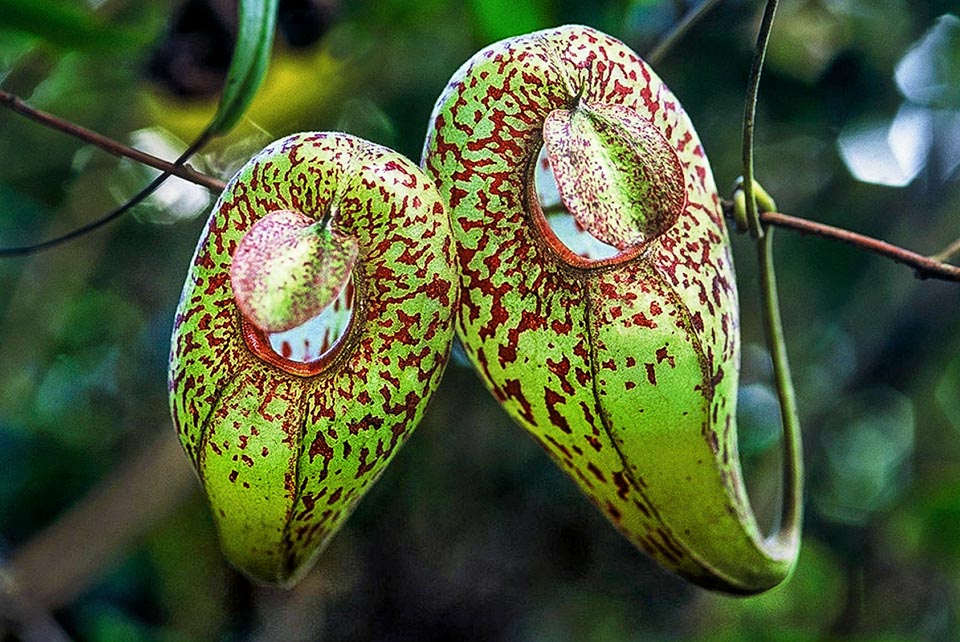
Nepenthes aristolochioides ascidium seems a flower of Aristolochia genus. The luminous transparency of the walls deceives insects entering there sure to be able to get out © Jeremy Holden
Some species, like Nepenthes rafflesiana, have a very sticky and elastic digestive liquid that prevents the prey from freeing itself until it drowns. Other species, add to the digestive liquid substances similar to strong anaesthetics (naphthoquinones) that put the prey to sleep just after its seizing; this serves to prevent this, with its legs, attempting to ascend, may cause damage to the inner walls of the ascidium, rich in secreting glands.
Ascidia with very thin peristoma are found in Nepenthes gracilis Korth, this species allows the preys to move easily along the lower surface of the operculum covered by big waxy crystals, but when the operculum, that is elastic, is hit by raindrops, begins to vibrate until the preys lose stability thus ending up inside the ascidium.
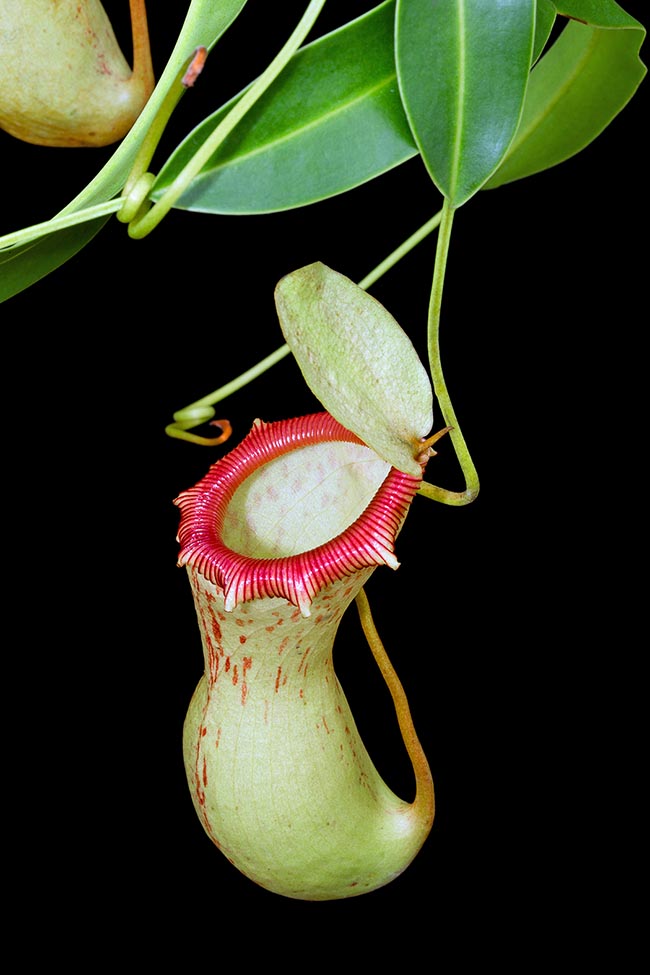
Endemic to Filipino forests, from 1000 to 2000 m of altitude, Nepenthes ventricosa attracts passing-by insects with red peristome, rich in nectariferous glands, emphasized by the contrast with the bright interior of the ascidium © Giuseppe Mazza
In the ascidia of Nepenthes smilesii Hemsl. are found spiders, millipedes, scorpions (Lychas spp.), ants (Oecophylla ssp.) and also zoophagous insects predators of Arthropods (Reduviidae) and some live larvae of Toxorhynchites spp. (Culicidae).
The spider Misumenops nepenthicola (Pocock, 1898) nourishes of the flies seized by some species of Nepenthes and the crab Geosesarma malayanum Ng & Lim, 1986 seizes the live preys in Nepenthes ampullaria.
In Nepenthes rajah, for the ascidia of remarkable size with covers exuding sweet and very attractive nectar, have been found even rats.
Small frogs reproduce only in the chambers full of water of some species of Nepenthes and their small size and the reduced membrane of the hind limbs are adaptations necessary for allowing them to move easily in the waxy zone of the ascidia without slipping.
In fact, the male of Microhyla borneensis Parker (1928), the smallest frog in Borneo, just over one centimetre long, tucks on the lip of Nepenthes ampullaria to attract the female for laying the eggs inside the ascidium.
Also Nepenthes hurrelliana Cheek & A. L. Lamb hosts in the pitcher males of some species of frogs of the genus Philautus (Rhacophoridae) that, immune to digestive enzymes, utilize it as a sound box in order to amplify their coupling calls.
The ascidia are therefore utilized as brood chambers taking advantage of the liquids contained there for the growth of the tadpoles.
Many species of Nepenthes are generalist and do not choose the preys whilst others do select them.
Nepenthes albomarginata has specialized in trapping almost exclusively the termites being these ones attracted by its white hairs (the specific name “albomarginata” comes from the Latin. albus, white and marginatus, with margin, rightly refers to the ring of white hairs under the peristome) because they are greedy of them, but the hairs, made heavy, detachand hundreds or thousands of termites end up into the ascidium. With this mechanism the plant no longer needs to produce nectar with a net energy saving.
Nepenthes lowii Hook.f. has adopted another mechanism to get the organic substance: the plant secretes a sweet and milky liquid that attracts the preys having the size of small birds and shrews.
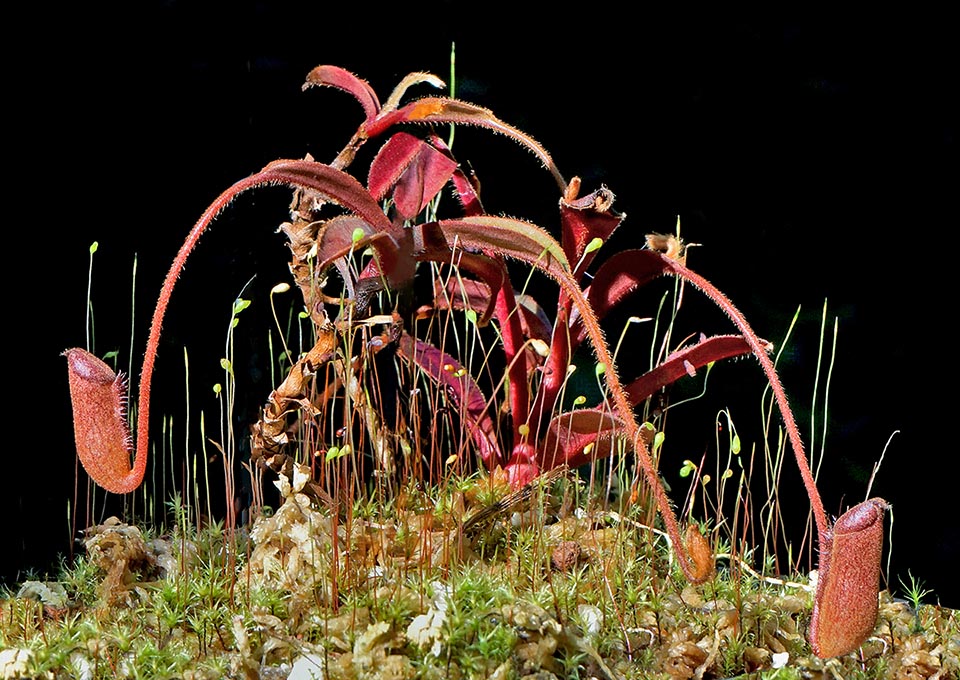
Endemic to Sibuyan Island, Philippines, where grows from 1400 to 1900 m of altitude, Nepenthes argentii has reddish ascidia with intensely coloured toothed peristome. Upper ascidia are absent because it’s not a climbing species. This species difficult to cultivate, is however a plant very sought for by the collectors © Miloslav Dobšík
However the liquid contains a powerful laxative that stimulates the preys who eat it to defecate inside the ascidium granting in this way organic substance to the plant.
Also Nepenthes hemsleyana Macfarl. utilizes excrements, but those of the bats. The plant attracts them thanks to the capacity of the ascidium of reflecting the ultrasounds emitted by the chiropterans in order to orient them towards its opening. The chiropterans once inside the ascidium, settle there because they feel protected and in the meantime they supply the plant with nitrogen-rich manure. The superior ascidia are shaped in such a way to be ideal as resting place for the small Hardwicke’s woolly bat (Kerivoula hardwickii Horsfield, 1824) that inside the ascidia is protected by parasites and predators.
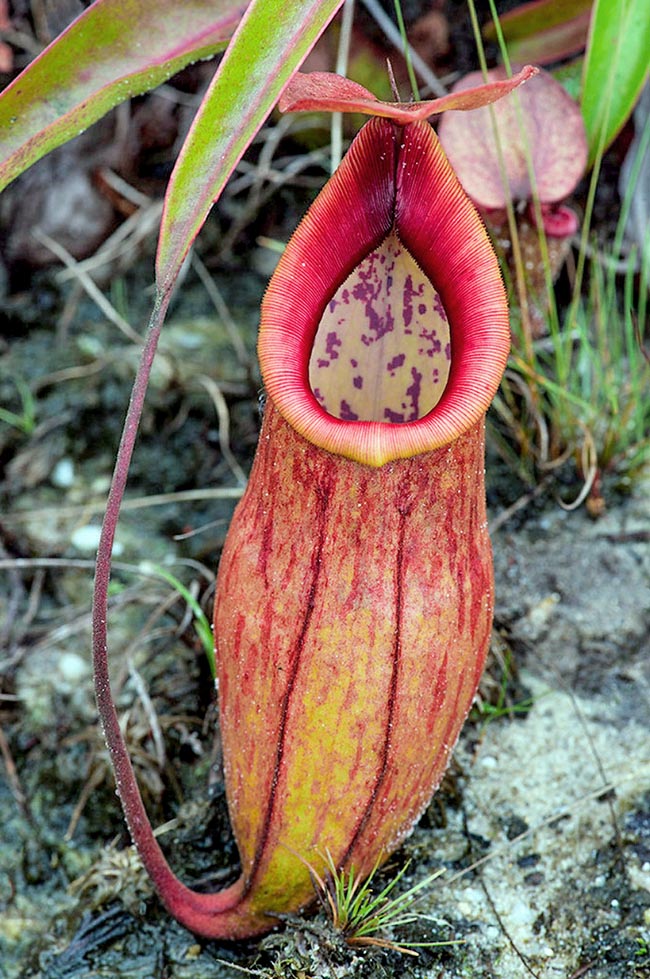
In ascidia of Nepenthes smilesii stand spiders, millipedes, scorpions (Lychas spp.), ants (Oecophylla ssp.) and also some zoophagous insects predators of Arthropods (Reduviidae) and some Toxorhynchites ssp. (Culicidae) live larvae © Jeremy Holden
Nepenthes ampullaria gets most of its nutrients with the digestion of the leaves falling inside of its big ascidia (up to 7 cm broad and 10 cm tall).
It is therefore a partially detritivorous plant being able to host in the ascidia various animals, some in a mutualism relationship, like the larvae of mosquito that facilitate digestion of the foliar waste and transfer the nitrogen to the plant by means of the excretion of ammonium ions.
Can also be present bacteria that digest the foliar debris transforming them into ammonium.
From these observations it is clear that the infauna (larvae of mosquito and bacteria) receives protection and food from the plant, while this benefits of the products of their digestion.
The Red List of the International Union for Conservation of Nature presently counts 123 species of Nepenthes.
The most threatened species are those of the rainforests of plains because since years is done the deforestation to make room for the agriculture (oil palm plantations), the housing constructions, the tourism.
Are endangered also those with a very restricted range such as, for instance, Nepenthes sumatrana (Miq.) Beck, endemic to Sumatra, where it grows from 0 to 800 m.
It is a climbing plant with up to 15 m long stems. It has coriaceous and petiolate leaves with lanceolate-obovate lamina up to 55 cm long and 9 cm broad. The lower ascidia are big (20 cm tall and 10 cm broad) and have up to 6 mm wide fringed wings. The peristome is cylindrical and is up to 10 mm broad with indistinct teeth. The IUCN Red List classifies this species as in critical danger (Critically Endangered, EN).
Also Nepenthes bicalcarata, endemic to the Bornean western coast peat bogs is classified by the IUCN Red List as a vulnerable species (Vulnerable, VU).
They are at risk as well the ultramafic obligated species because they are particularly vulnerable to the open air mining operations extractions of metals such as manganese, nickel and cobalt. Among these we cite Nepenthes philippinensis Macfarl., endemic to Philippines, where it grows from 0 to 600 m of altitude, and Nepenthes argentii of the island of Sibuyan, in the Philippines, where it grows at 1400-1900 m of altitude.
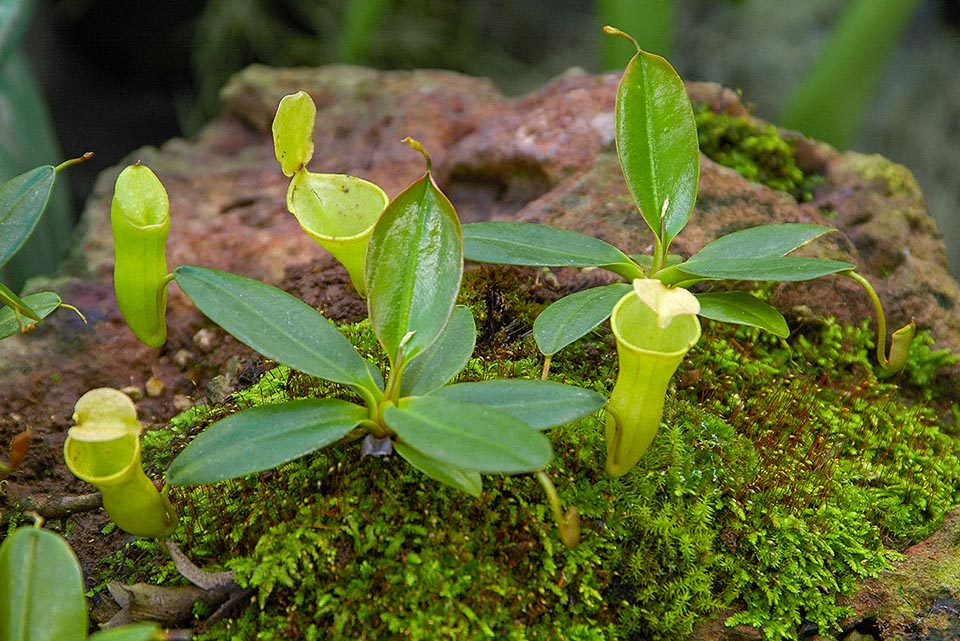
Nepenthes campanulata of mount Ilas Bungaan, characterized by small bell-shaped ascidia, has been destroyed during the vast wood fires of Borneo in the years 1983-1984. Luckily, in 1997 it has been found in a second site in the National Park of Gunung Mulu in Sarawak (Borneo) and now is classified by IUCN as a vulnerable species © Eric Hunt
Nepenthes clipeata Danser, endemic to the Mount Kelam (Borneo), unique granite massif exceeding the 300 m of height in the range, whilst it is absent from the other granitic mountains of the region even if higher such as Gunung Saran (1741 m) and Bukit Kujau (1308).
Due to its rarity and its ascidia, it has assumed a high horticultural value because it is very much sought for by the collectors of Nepenthes. Despite being protected by Indonesian law, the poaching and the repeated fires have reduced its population to only very few specimens. After the IUCN Red List it is a Critically endangered, CR species.
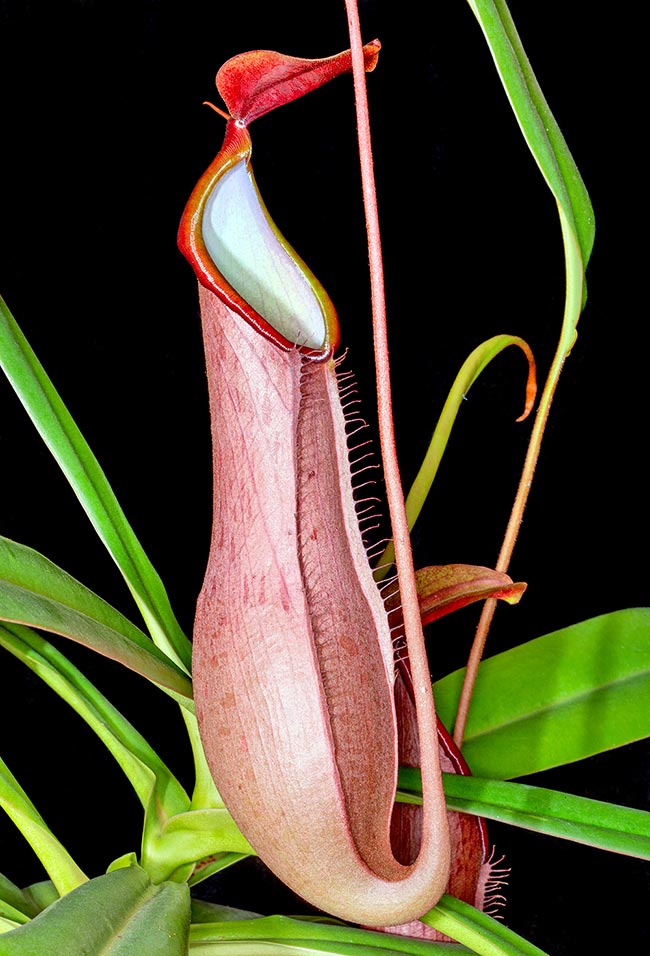
Classified vulnerable, Nepenthes merrilliana, endemic to the Philippines, produces ascidia among the biggest of the genus that compete with those of Nepenthes rajah. The lower ones, 14 cm broad, in fact can be 35 cm long © Giuseppe Mazza
The population of Nepenthes campanulata Sh. Kurata, originally discovered on the mount Ilas Bungaan, has been destroyed during the widespread forest fires of Borneo of 1983-1984 and the species has been deemed extinct until 1997 when it has been found in a second site at more than 400 km in the Gunung Mulu National Park in Sarawak (Borneo). Now IUCN classifies it as a Vulnerable, VU, species.
Nepenthes aristolochioides Jebb & Cheek, is endemic to Sumatra in only two locations (Mount Kerinci and Mount Tujuh from 2000 to 2400 m of altitude). It owes its name to the shape of the ascidium resembling the flower of an Aristolochia. The IUCN Red List deems it as a Critically Endangered, CR. species.
Nepenthes argentii is a plant endemic to the island of Sibuyan, Philippines, where it grows from 1400 to 1900 m of altitude. It is a species having no superior ascidium as it is not a climber. The ascidia are small, red or burgundy, with toothed peristome and of intense colour. This species is difficult to cultivate, but is highly sought after by the collectors. The IUCN Red List classifies it as a vulnerable species (Vulnerable, VU).
Nepenthes madagascariensis is a species endemic to Madagascar, where it lives at low altitudes along the eastern coast. It prefers the habitats of the humid zones among which peat bogs, swamps, swampy areas, and peaty or sandy soils.
Its leaves are up to 40 cm long and from them detach the ascidium on long and thin tendrils.
The ascidia are up to 25 cm long. The lowest ones touch the soil, have a bulbous shape and are constantly reddish violet whilst the upper ones, that take form when the plant climbs, are infundibuliform and, usually, are bright yellow. The two types of ascidia differ due to the different capacity of attracting the preys.
The ants are present in the lowest ones, whilst the flying insects are seized by the upper ones. Overall, the ascidia, thanks to their bright colour, to the nectar present on its opening and to the smell of the fluid, catch preys formed by Formicides (80,2%), Dipterans (9,7%) and Coleopterans (4,4%). Moreover, the pitchers of Nepenthes madagascariensis host various specialized arthropods, among which larvae of mosquito Uranotaenia bosseri Grjebine, 1979, Uranotaenia belkini Grjebine, 1979, mites (Creutzeria sp.) and larvae of grass flies (Chloropidae). Have been found also two species of infaunal spiders: Synema obscuripes Dahl 1907 and Anelosimus decaryi Fage, 1930).
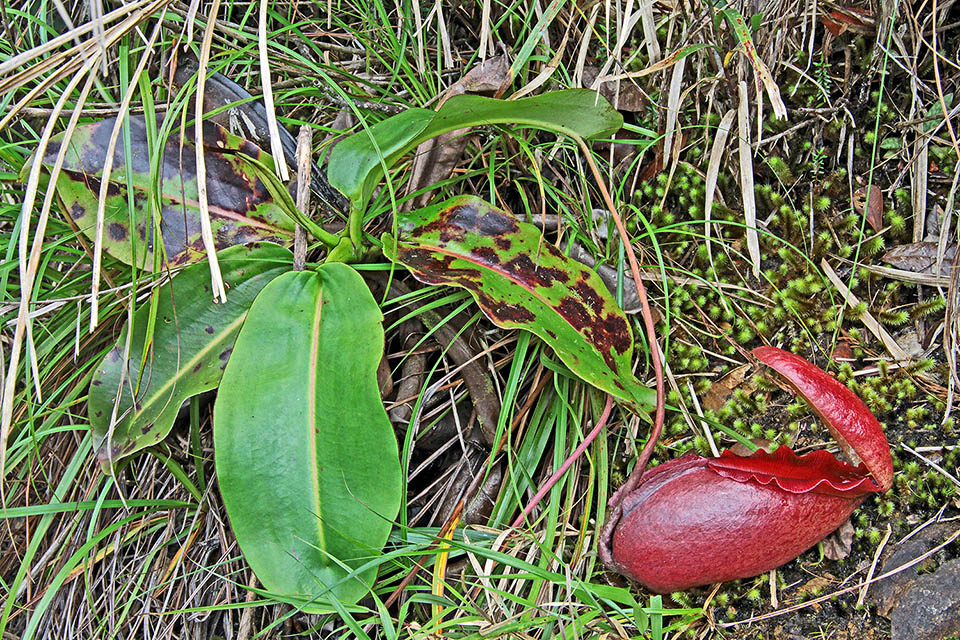
Malay Borneo Nepenthes rajah is considered as a species threatened by extinction. Known as “monkey cup” because of the liquid of ascidia sought after by the primates is a plant able to grow on soils having high contents of heavy metals. Its red ascidia are very big with a cover at times oversized. The trade of the wild specimens is forbidden © Hermine Kolb
Nepenthes pervillei is the only carnivorous plant of the Seychelles, where it is endemic in the islands of Mahé and Silhouette whose roots go deep in the rocky fissures completely exposed to the sun of the granite mountains. It is found in the altitudinal range from 350 to 750 m above the sea level. It is a primitive species and after the molecular results occupies a basal position within the genus Nepenthes.
The colour of the Nepenthes pervillei changes over time. The youngest plants tend to display a mainly brown-reddish shade with a cover of thin hairs, whilst the mature specimens tend to transform from greenish yellow to violet. The leaves are numerous, short, with rounded apex. The ascidia, supported by a short tendril, have the shape of an amphora and reach a height of about 14 cm and an average diametre of only 3 cm.
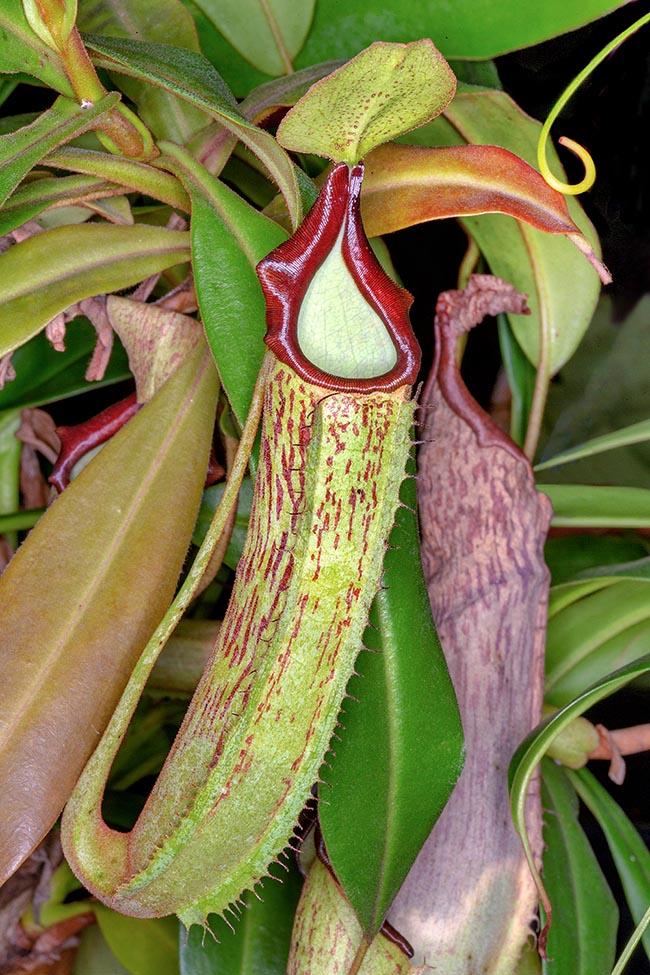
The lower ascidia of Nepenthes maxima measure 10-25 cm, with stripes varying from red to dark brown on pale green background. The upper ones a infundibuliform, of pale green colour with the peristome streaked red © Giuseppe Mazza
The lowest ascidia are mainly red whilst the upper ones are mainly yellow-orange. The preys are mostly ants, but, in symbiosis, is found also the mite Creutzeria seychellensis Nesbilt 1979. The IUCN Red List classifies Nepenthes pervillei as a species at low risk (Least concern, LC).
Nepenthes vieillardii is a species endemic to New Caledonia and lives in the dry forests at about 900 metres of altitude. Its distribution is the easternmost of all species of Nepenthes In its ascidia it hosts, in symbiosis, the mosquito Tripteroides caledonicus. Nepenthes vieillardii is a species rather difficult to cultivate also because it grows on soils formed by ultramafic rocks. However for its cultivation we suggest a substratum made by a clayey mix (akadama), like that employed for preparing the loams for bonsai or the bottoms of freshwater aquaria. It is good to get the loam well dried up between a watering and another.
Nepenthes khasiana is the only Indian species of Nepenthes, abundantly collected for its botanical uniqueness, for its ornamental value and for the medicinal properties. The population is seriously fragmented due to the human settlements, construction of roads and urbanization; this has caused an enormous pressure on the species putting it at risk of extinction. Now it is inserted in the IUCN Red List as Endangered, EN in the Appendix I of CITES and in the Indian government (List of Exports and ‘Schedule VI’ of The Wild Life Protection Act. 1972).
Nepenthes merrilliana Macfarl. is a species endemic to the Philippines where it grows from the sea level up to 1100 m of altitude. It produces ascidia standing among the biggest of the genus competing with those of Nepenthes rajah. The lowest ascidia are usually up to 35 cm tall and 14 cm broad, though bigger at times, and are wholly, widely cylindrical or ellipsoidal. The IUCN Red List classifies it as a vulnerable species (Vulnerable, VU).
Nepenthes mirabilis lives in the forests, in the prairies, in the swamps, on the roadsides and in the humid, not cultivated lands, also on sandy soils from the sea level to 400 of altitude, all over the Asian South-East, China and Australia. The species shows a great variability all over its range. Nepenthes mirabilis hosts, in its ascidia, also a complex community of bacteria. The IUCN Red List lists it as a species at minimum risk (Least Concern, LC), but the Hong Kong forest regulation indicates it as a protected species (Forestry Regulations Cap. 96A). One of the most remarkable varieties is Nepenthes mirabilis var. echinostoma (Hook.f.) Hort.Slack ex J.H.Adam & Wilcock, endemic to Brunei and Sarawak, characterized a very ample peristome.
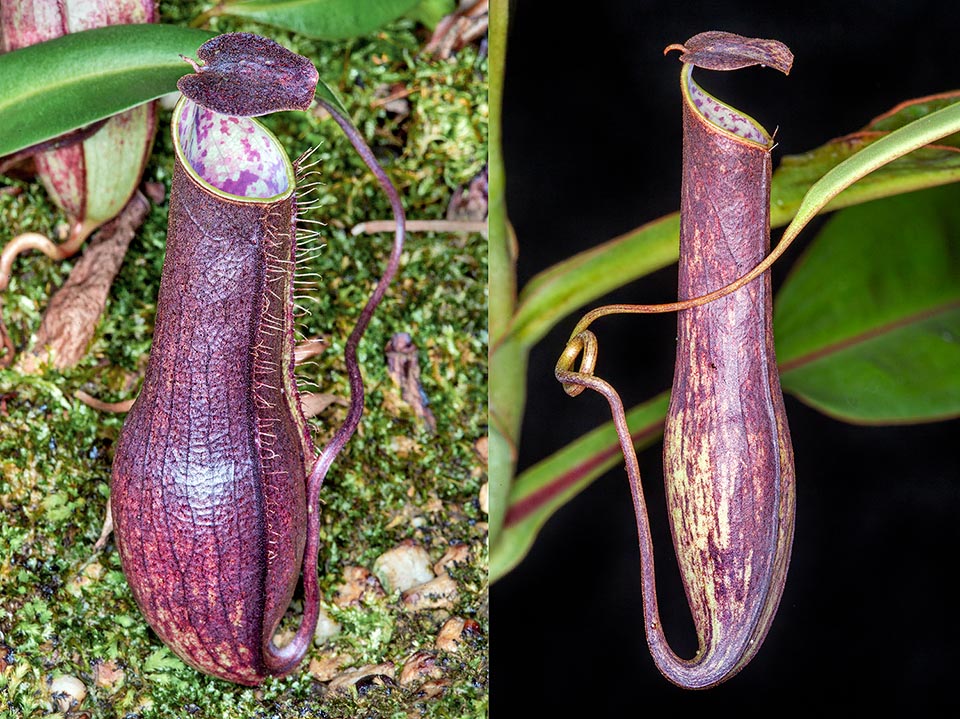
Lower and upper ascidium of Nepenthes gracilis, species with thin peristoma typical to the shady and flat jungles of South-East Asia. It catches prey with an operculum thin and flexible rich in wax crystals that detach upon the first rain drops begins to vibrate. The preys, usually ants, thus lose balance and fall into the trap © Giuseppe Mazza
Nepenthes jamban is a species endemic to Sumatra and lives in the upper mountain mossy forest, from 1800 to 2100 m of altitude. The upper ascidia are much bigger than the lowest ones, reaching the 12 cm of height and 5,2 of width, with flat peristome, 6 mm broad with prominent teeth. The cover is kept over the opening of the ascidium with a corner of about 45 degrees to prevent the rain water from filling up the ascidium. The big size of the upper ascidia serves for trapping numerous preys, such as wasps and crickets.
Nepenthes rigidifolia Akhriadi, Hernawati & Tamin, known only in one single location in the province of northern Sumatra (Indonesia), has been decimated by poaching and by the destruction of its habitat and now is classified by the IUCN Red List as a Critically Endangered, CR species at a very high risk of extinction.
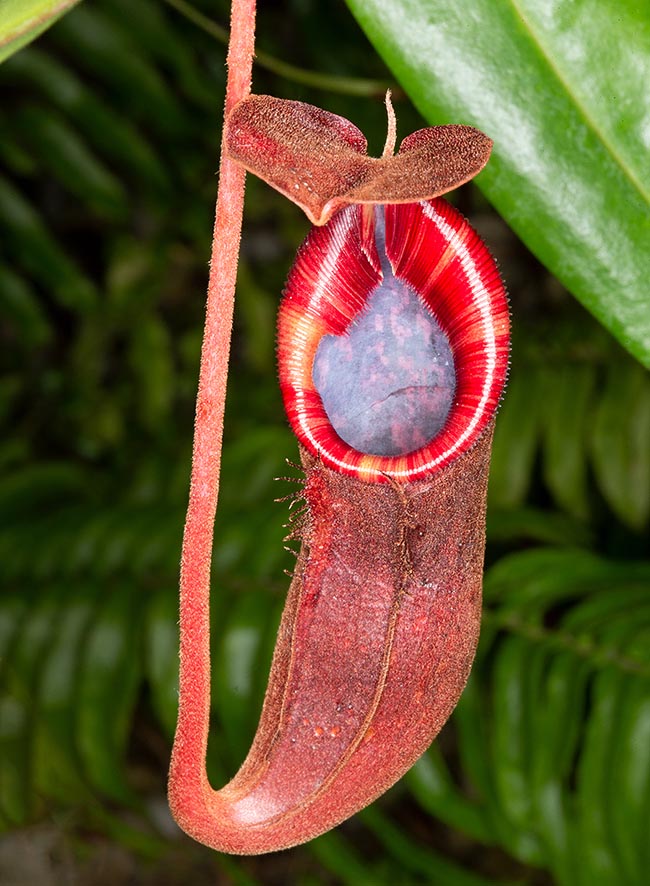
Often present in collections, Nepenthes thorelli x trusmadiensis is a very resistant and strong hybrid © G. Mazza
Nepenthes fusca, epiphyte of the mountain forests of Borneo is considered as Vulnerable, VU in nature, due to the continuous deforestation.
Nepenthes lowii, endemic to Borneo, where it grows at 1650-2600 m of altitude, deemed Vulnerable VU by the IUCN Red List.
Nepenthes macrophylla (Marabini) Jebb & Cheek, endemic to Mount Trusmadi, Borneo, where it grows at 2200-2642 m, is deemed as seriously threatened therefore at very high risk of extinction (Critically Endangered, CR).
Nepenthes rajah of the Malay Borneo is considered as a species threatened of extinction and the trade of the wild specimens is absolutely forbidden.
Nepenthes suratensis M.Catal., endemic to the province of Surat Thani, Thailand, where it grows near the sea level in the coastal savannah and in the prairies, is deemed as a species with an extremely high risk hence seriously threatened in nature (Critically Endangered, CR).
Many species of Nepenthes are utilized in traditional medicine because of the presence of numerous phytochemical constituents responsible for various pharmacological properties with broad medicinal spectrum.
In the past, in north-eastern India, the herbalists prescribed the liquid contained in the pitchers of Nepenthes khasiana for treating diabetes mellitus and also for treating conjunctivitis, problems to the ears and gynecological problems. The Khasi people, ethnic group of the State of Meghalaya (north-eastern India) and the Garo in Bangladesh, utilize the liquid of the pitcher not open to treat the cataract and the night blindness. The whole closed ascidium, with its contents is transformed into a paste for treating several diseases, leprosy included. Moreover, the liquid of the still closed ascidium mixed with rice beer is assumed to relieve urinary obstructions and for the treatment of problems of stomach, diabetes and diseases of the female reproductive system.
The Dayaks, population of Kalimantan and Sarawak (Borneo), utilize the liquid of the closed ascidia of various species of Nepenthes to treat the cough.In Malaysia the leaves of some species of Nepenthes are used as astringents, the decoction of root of Nepenthes ampullaria is employed for treating asthma whilst, in the past, for treating this disease, was used the decoction of its stems.
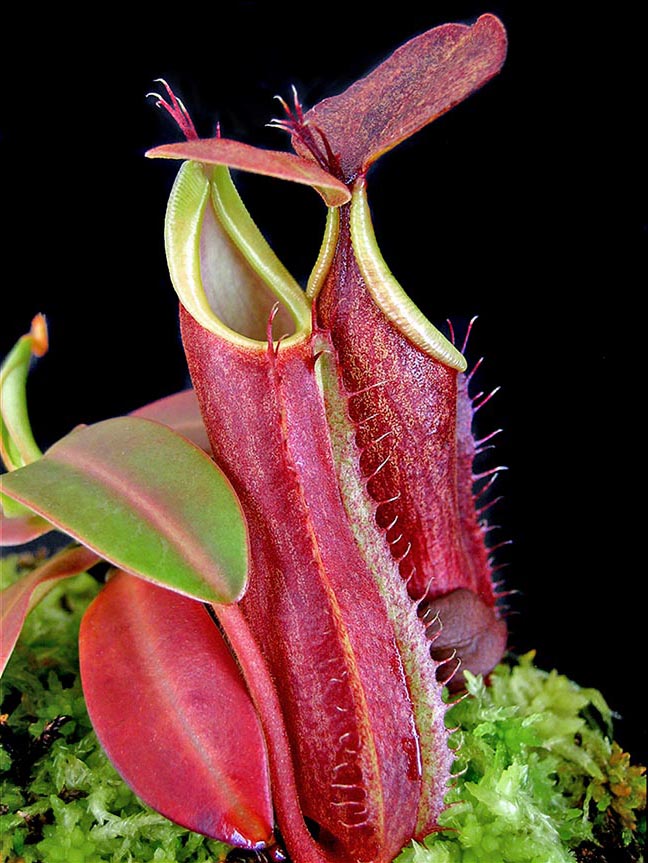
Nepenthes sanguinea lower pitcher is red-orange with interior green-yellow. The insects are attracted by the colours and by a sugary substance. Species available on market, needs acidic soil with peat and humus © Matthew Norton
In Vietnam, Nepenthes mirabilis is used for treating the gastric ulcer, jaundice, hypertension, kidney stones and for hepatitis.
In New Guinea the ascidia of Nepenthes were utilized, by the male populations, as phallocrypts, sheaths for covering the penis.
In Sumatra the decoctions of the root of Nepenthes ampullaria and of Nepenthes gracilis were often used for the abdominal pains.
In Irian Jaya and in Kalimantan the roots of Nepenthes reinwardtiana are utilized to facilitate the skin healing and as astringent. Its big pitchers are utilized to cook the rice that impregnates with a very particular taste.
The stems of various species are used to make ropes and those of Nepenthes ampullaria are of excellent quality because they are very resistant and suitable for the enclosures.
Various species of the genus Nepenthes were popular in Europe during the second half of the XIX century, when the wealthy had the winter gardens due to the fashion of collecting tropical plants, in particular orchids, due to the beauty of their flowers, and carnivorous plants due to the typical shape of their ascidia. After the second world war, the tastes have changed and the collection of Nepenthes has been very reduced. Nowadays the interest has come back and many species of Nepenthes are appreciated by collectors and by the vast public increasing their trade that, worldwide, probably exceeds the 15 million dollars per year. The main markets are western Europe, Japan and the USA.
To meet buyers’ demand, is utilized the technique of micropropagation, that is the artificial culture of the tissues, and also cuttings or seeds taken from species in cultivation but not in nature.
The trade is regulated by the Washington Convention (Convention on International Trade in Endangered Species of Wild Fauna and Flora, CITES) that includes Nepenthes khasiana (India) and Nepenthes rajah into the Appendix I, all others in the Appendix II.
For the Nepenthes cultivation, due to their quite different habitats, it is difficult to give precise indications applicable to all species existing on the market. With the purpose of giving general indications for the cultivation, the different species of Nepenthes have been divided into great categories depending on the environments where they live.
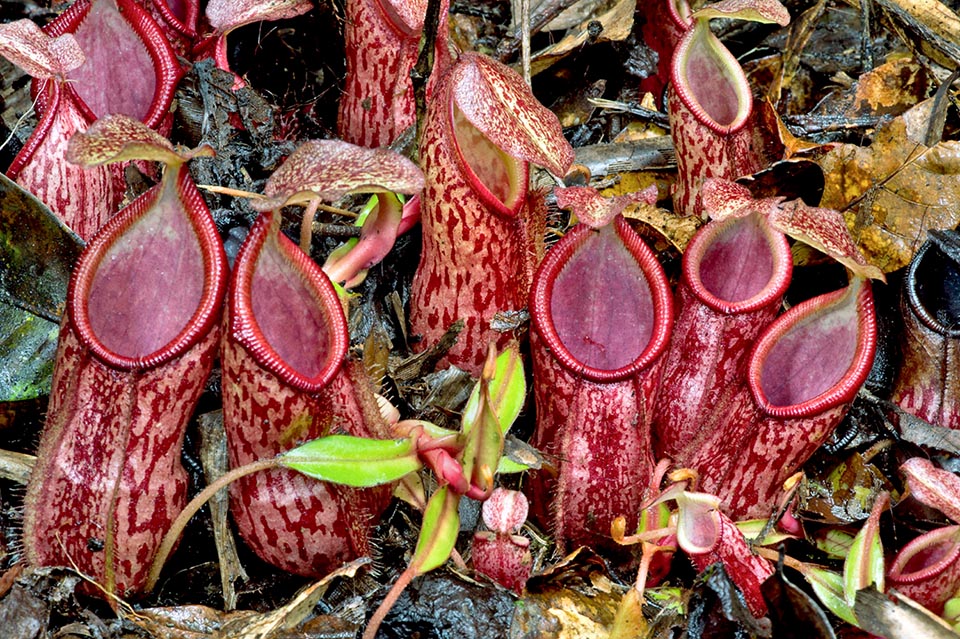
Striking and picturesque imagine in the wild of the lively lower pitchers of Nepenthes gymnaphora, plant endemic to Java and Sumatra, where grows between 600 and 2800 metres of altitude. After some authors the Sumatra specimens, like this shown in the photo, should be ascribed to the very similar Nepenthes pectinata © Jeremy Holden
1) Nepenthes of plain (lowland) from 0 m to 1000 m;
2) Nepenthes of the intermediate zone (intermediate) from 1000 m to 1500 m;
3) Nepenthes of medium-high altitude (highland) from 1500 m to 2500 m;
4) Nepenthes of high altitude (ultra highland) from 2500 m to 3500 m.
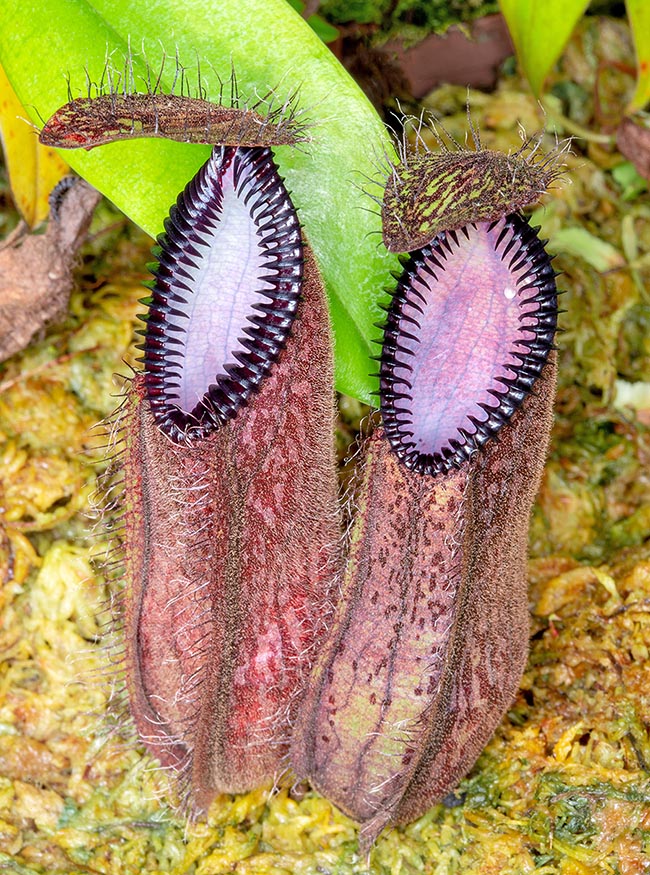
The lower ascidia of Nepenthes hamata, from Latin “hamata” meaning hooked, have a violet striped body with peristome formed by a series of hooked teeth, almost black, very marked and facing inwards © Giuseppe Mazza
As the species present in this last line are few (i.e. Nepenthes lamii Jebb & Cheek) and most of them stand also in the lower line (i.e. Nepenthes diatas Jebb & Cheek, Nepenthes densiflora Danser, Nepenthes villosa Hook.f., Nepenthes aristolochioides) it is preferred to include them among the Nepenthes highland.
Among the species of the plain (lowland) we cite: Nepenthes tenax (from 0 to 80 m), Nepenthes suratensis (from 0 to 200 m).
Among the intermediate zone species (intermediate): Nepenthes aenigma Nuytemans, W.Suarez & Calaramo (da 1150 a 1250m), Nepenthes deaniana Macfarl. (from 1180 to 1296 m), Nepenthes leonardoi S. McPherson, Bourke, Cervancia, Jaunzems & A.S.Rob. (from 1300 to 1490 m).
Among the species of medium-high altitude (highland) we cite: Nepenthes alba Ridl. (from 1600 to 2187 m), Nepenthes alzapan Jebb & Cheek (from 1750 to 1850 m), Nepenthes ceciliae Gronem., Coritico, Micheler, Marwinski, Acil & V.B.Amoroso (from 1500 to 1880 m), Nepenthes diabolica A.Bianchi, Chi.C.Lee, Golos, Mey, M.Mansur & A.S.Rob. (from 2200 to 2300 m, Nepenthes jamban Chi.C.Lee, Hernawati & Akhriadi (from 1800 ato2100 m), Nepenthes lingulata Chi.C.Lee, Hernawati & Akhriadi (from 700 to 2100 m), Nepenthes rhombicaulis Sh.Kurata (from 1600 to 2000 m).
There is no lack of species that can be encountered in more lines such as Nepenthes maxima Reinw. ex Nees (from 40 to 2600 m), Nepenthes reinwardtiana (from 0 to 2200 m), Nepenthes ampullaria (from 0 to 2100 m), Nepenthes tentaculata Hook.f. (from 400 to 2550 m), Nepenthes fusca (from 300 to 2500 m), Nepenthes veitchii Hook.f. (from 0 to 1600 m).
The Nepenthes are tropical plants adapted, with some exception, to a warm humid climate consequently the cultivation in non tropical areas requires a closed or half closed environment, in glas or in plexiglas (terrarium) where they are grown trying to reproduce, as far as possible, the environmental conditions of growth of the places of origin. Many species can be cultivated in a warmed greenhouse. The lowland species require a terrarium that must recreate the conditions of the zones of the tropical plain with very high humidity over the 80% and constant temperatures during the day as well as during the night, usually b25-28 °C. This is a terrarium fairly easy to arrange, as in winter the temperature can be increased with the normal house warming systems and in summer the plants, if placed indoor or out, tolerate our high temperatures up to 35 °C. The humidity may be obtained either with an automatic nebulizator or with frequent distilled water jets.
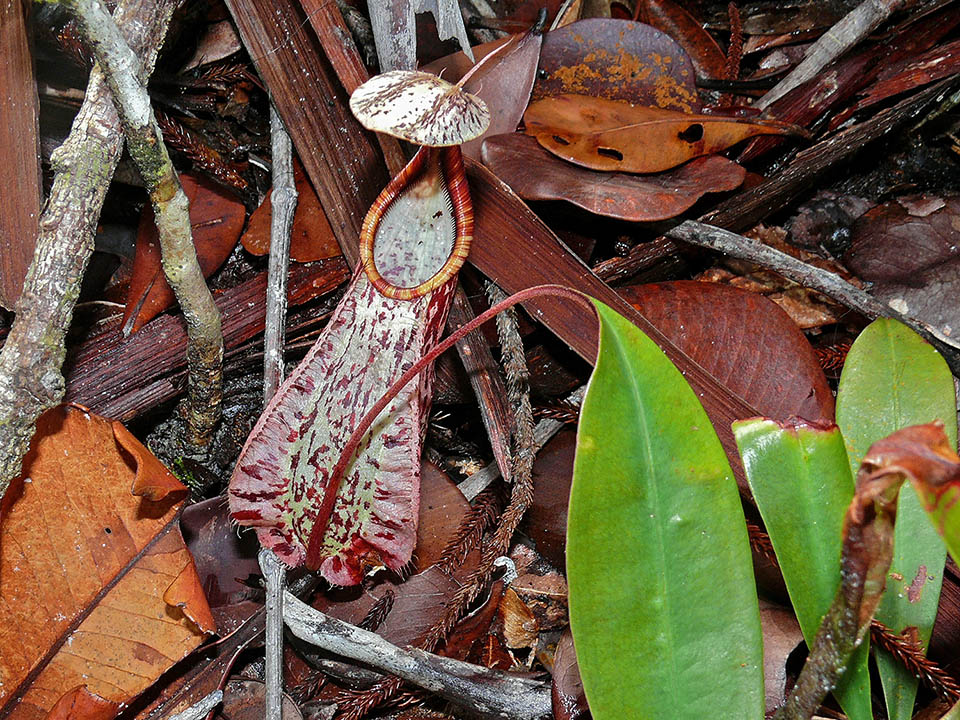
Nepenthes rafflesiana has the lower ascidia shaped like an ampulla. 5 cm broad and 12-20 cm tall, they can reach 40 cm in the biggest forms © Bernard Dupont
In the nurseries are usually present species able to tolerate different conditions and consequently easy to grow.
For the species of the intermediate zone (intermediate) the terrarium must be a compromise with intermediate conditions between the plain ones and those of medium-high altitude with temperatures going from 30 to 20 °C and humidity over 80%.
Many species can be cultivated also in a terrarium for the highland ones. These need the conditions found in the tropical mountains, therefore temperatures not exceeding the 30 °C the day and a thermal jump of about 15 °C during the night. These species are suitable in the autumn and winter seasons to the European latitudes, being much easier to keep the internal temperature controlled. Usually, the terrarium is good only when the plants are small, but there are species that tend to become cumbersome, and hence it would not be enough any more, unless one remarkably bigger.
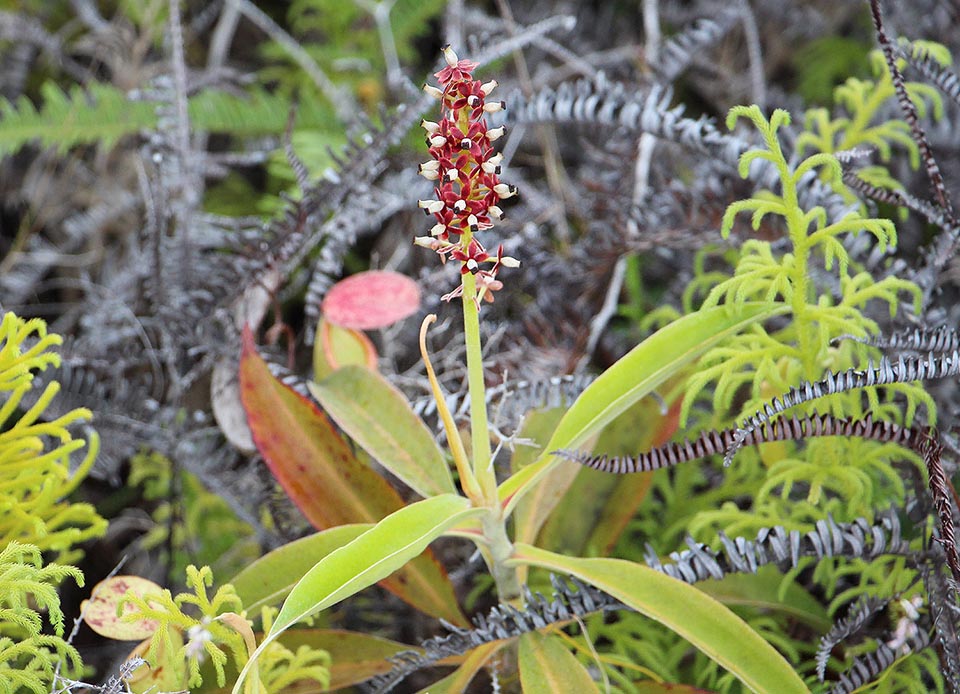
Blooming Nepenthes mirabilis. We note the numerous female flowers with the four tepals perianth and pubescent elliptic ovary © J. B. Friday
As most of the Nepenthes venture in the upper portion of the rainforest, preferring the quite bright light, but not the direct sun, is to be avoided in cultivation to expose them to the direct sun, but to keep them only in diffused light.Moreover, it is good that the humidity is always high, usually 70% – 90% or more, for almost all three typologies of Nepenthes but to avoid soaking the soil with water as this would cause root rot. The absence of ascidia is a sign that the air is dry. The highland species grow only if there are containers able to furnish the low temperatures necessary and this, in particular, for the youngest plant.
The Nepenthes can benefit from the foliar fertilization that may be done in spring and in summer. In fact, the plants can be treated with a mild solution of fertilizer for orchids several times a month that may help them in getting a good growth.
The bright windowsills are suitable for the growth of some species provided however that every day nebulizations are done with distilled water.
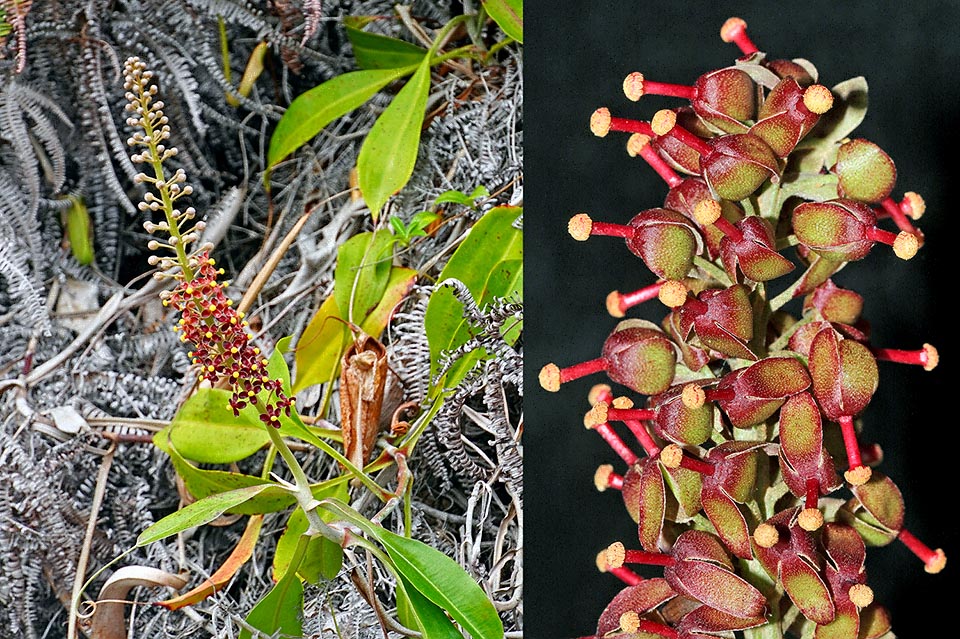
Male inflorescence of Nepenthes rafflesiana. The stamens have the filaments merged in column and yellow anthers. Pollination is entrusted to flies and night moths © Reuben C. J. Lim (left) and © Cerlin Ng (right)
The use of loose cultivation land and with scarce microelements maintains the roots aerated and allows the water in excess to drain quickly while maintaining the necessary humidity.
Suitable soils for the Nepenthes exist on the market. Usually, they are a combination of moss, gern and coconut fibre, sand, perlite and pumice rock.
If we want an overtime lasting growth we must use rain water, distilled or demineralized by ion exchange.
To recover the nitrogen, it is good to put inside the ascidia small dried insects without exceeding because the overfeeding causes its darkening or the rottenness.
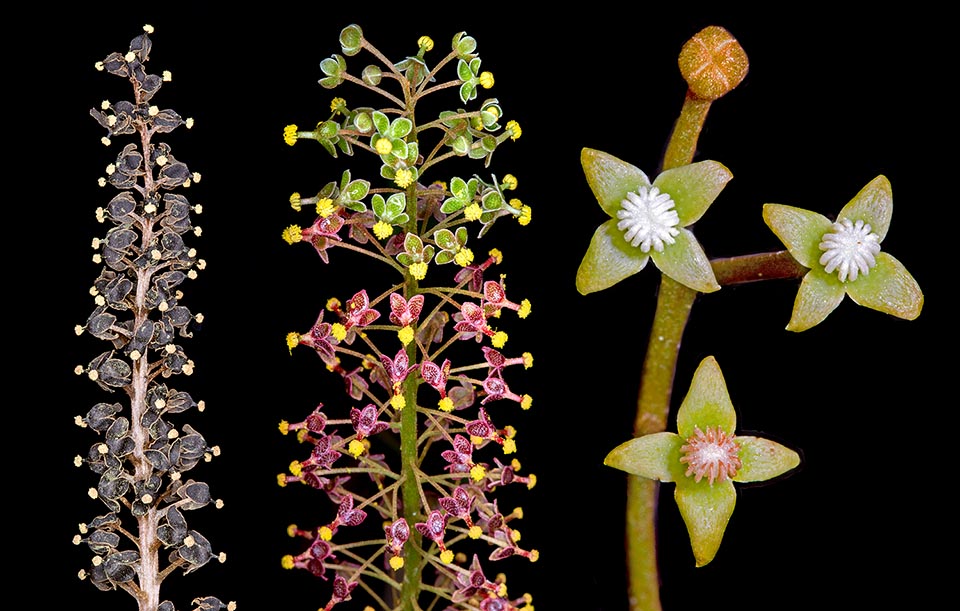
Male inflorescences of Nepenthes gracilis (left) and Nepenthes maxiama (centre). Right, three male flowers of Nepenthes pervillei © Giuseppe Mazza
When adult, Nepenthes veitchii is a nice plant covered by brown hairs with a bit stocky pitchers with big coloured peristomes, colourful striped and flared. It also adapts in environments with low humidity. Quite spectacular is the natural hybrid Nepenthes robcantleyi Cheek, species endemic to Mindanao, Philippines, with brown-reddish ascidia, at times with green wings and peristome usually of reddish brown or uniform black colour but the inner pale green margin. Also the upper surface of the cover varies from dark red to black.
Nepenthes maxima, has an ample distribution (New Guinea, Sulawesi and the Molucca Islands) and a great variability of its pitchers. The lower ones are big, 10-25 cm long, with stripes varying from red to dark brown on a clear green background. With age the peristome turns from red to almost black. The upper ascidia are infundibuliform and are of pale green colour with the peristome streaked with red.
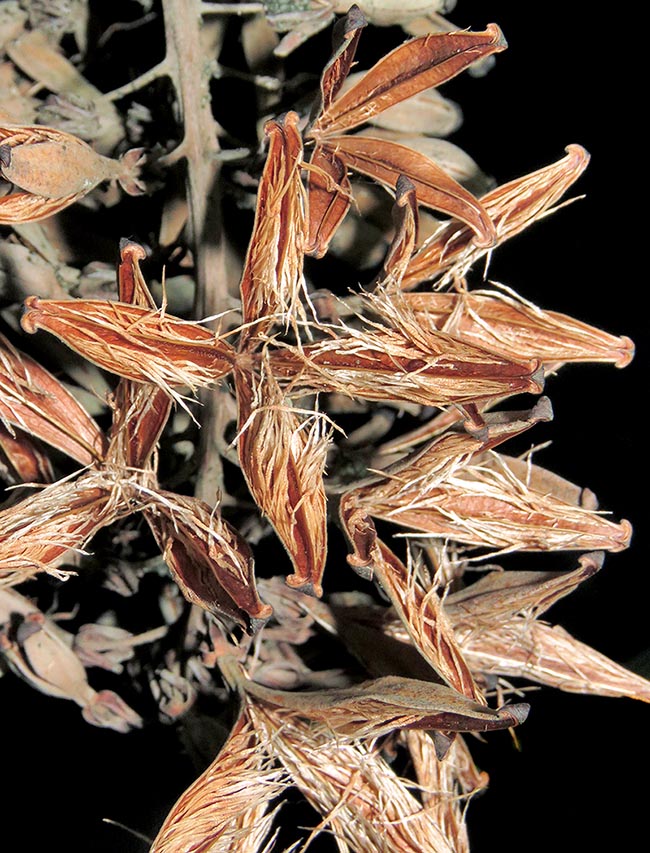
The fruits of Nepenthes are dehiscent coriaceous capsules with many filiform seeds dispersed by the wind © Reuben C. J. Lim
On the market this species is available in many varieties, including the wavy leaf shape (Nepenthes maxima f. undulata Sh.Kurata, Atsumi & Y.Komatsu), very attractive due to the intense red/violet leaves with neatly wavy margins.
Nepenthes ventricosa Blanco is a species endemic to the mountain forests in Philippines, where it grows from 1000 to 2000 m of altitude. In nature it spontaneously hybridizes with Nepenthes alata Blanco originating Nepenthes × ventrata Hort. ex Fleming. This species is rather easy to cultivate in a flat even behind a window.
Day temperatures should be maintained around 18-27 °C, maximum 35 °C, with a lowest of 10 °C by night.
It is very attractive due to the fleshy ascidia, of pale green colour with red stripes, up to 20 cm long, shaped like a pot-bellied carafe. The peristome is red with nectariferous glands. In cultivation the leaves are to be frequently nebulized many times a day, especially during the summer period. It can be reproduced detaching from the mother plant small tufts with roots to be planted in loam of sphagnum acid peat and perlite in equal parts.
Among the species available on the market we cite: Nepenthes alata, Nepenthes sanguinea Lindl., Nepenthes truncata Macfarl., Nepenthes thorelii Lecomte, Nepenthes reinwardtiana, Nepenthes rajah.
The natural hybrids of Nepenthes are better traded because they are easier to cultivate than the pure species.
In fact, in the market we find several hybrids such as Nepenthes x ventrata It is a very common hybrid plant, robust but with a rather slow growth. It has bright green leaves and ascidia with green-reddish colouration. It is cultivated in warmed-up greenhouses where the temperature must never go down under 15 °C / 18 °C and must never go up over 38 °C. The environment of cultivation must have a high humidity rate (over 80%). On the market are also available Nepenthes ‘Bloody Mary’ with blood red pitchers, Nepenthes ‘Red Beauty’ and Nepenthes xhookeriana. This last is a hybrid obtained by cross between Nepenthes ampullaria and Nepenthes rafflesiana with green leavesduring the winter period may assume a reddish colouration.
Usually, the ascidia are 10 cm tall and 7 cm broad whilst their colour is cream with reddish spots.
The hybrid Nepenthes x miranda, classified as lowland, adapts for the most part to the domestic environment. It produces green ascidia with brown-red spots that may reach the length of 25 – 35 centimetres with almost vertical opening and with a glossy red dark brown coloured margin.
→ To appreciate the biodiversity within NEPENTHACEAE family please click here.
